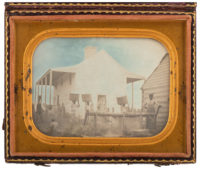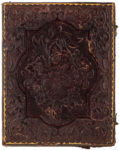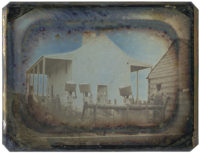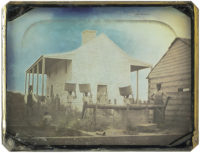 The only known antebellum image of enslaved African-Americans with cotton has been acquired by the Hall Family Foundation for the Nelson-Atkins Museum of Art in Kansas City, Missouri. The quarter plate daguerreotype was sold at Cowan’s American History auction in Cincinnati, Ohio, on November 15th and blew past the pre-sale estimate of $100,000 – $150,000 for a hammer price of $260,000 ($324,500 including buyer’s premium).
The only known antebellum image of enslaved African-Americans with cotton has been acquired by the Hall Family Foundation for the Nelson-Atkins Museum of Art in Kansas City, Missouri. The quarter plate daguerreotype was sold at Cowan’s American History auction in Cincinnati, Ohio, on November 15th and blew past the pre-sale estimate of $100,000 – $150,000 for a hammer price of $260,000 ($324,500 including buyer’s premium).
 The daguerreotype, still in its original leather case, was taken in the 1850s and is a posed tableau centered on three slaves carrying large baskets of cotton on their heads. In total there are 10 African-American enslaved individuals in the image, including several children. Behind them is a two-story house with front and rear galleries supported by posts. A log cabin is in the front right, perhaps a smokehouse or slave cabin. A crude well with a large timber crank mechanism is in the front center. A man in a top hat on the left is likely the owner.
The daguerreotype, still in its original leather case, was taken in the 1850s and is a posed tableau centered on three slaves carrying large baskets of cotton on their heads. In total there are 10 African-American enslaved individuals in the image, including several children. Behind them is a two-story house with front and rear galleries supported by posts. A log cabin is in the front right, perhaps a smokehouse or slave cabin. A crude well with a large timber crank mechanism is in the front center. A man in a top hat on the left is likely the owner.
Images of enslaved people working on the cotton plantations of Georgia and the Carolinas are extant, but they were captured by photographers who traveled south with the Union Army. They were taken at the large coastal planters owned by the wealthiest elites and worked by hundreds of slaves. This daguerreotype depicts slavery at a rural holding, the type of small-scale operation that was typical for the vast majority of slaveholders.
The daguerreotype was discovered in estate of Charles Gentry, Jr., after his death in Austin, Texas, in 2012. It was in good condition, but needed conservation to remove tape residue and dirt and to re-glaze and rebind the plate. The hinges of the case were also repaired.


Gentry was originally from Polk County, Georgia, so researchers investigated the origin of the image, they turned to the census and Slave Schedule records pertaining to the Gentry family in Georgia. Of several Gentrys living in Georgia in the decade before the Civil War, only one owned at least 10 slaves: Samuel T. Gentry of Greene County. The Federal Slave Schedules list him as owning between 15 and 18 men, women and children between 1850 and 1860.
“This piece—a record of the historical crime of slavery—is remarkable both for the power of its content and for its technical and aesthetic sophistication,” said [Keith F. Davis, Senior Curator, Photography, Nelson-Atkins Museum of Art]. “This is an unforgettable rendition of an era, and a way of life, that must never be forgotten or forgiven. At the same time, it markedly expands our understanding of the history of American photography. We have long believed that daguerreotypes such as this ‘should’ have been made in the 1850s; now we know that at least one actually was.”